Beverage Manufacturer Financial Model
This 20-Year, 3-Statement Beverage Manufacturer Financial Model includes revenue streams, cost structures, and financial statements to forecast the economic health of your drinks manufacturing company. These models assume revenue generation through up to 80 product lines, subscriptions, and partnerships.
20x Income Statements, Cash Flow Statements, Balance Sheets, OPEX Sheets, CAPEX sheets, Statement Summary Sheets, and Revenue Forecasting Charts, BEA charts, sales summary charts, employee salary tabs and expenses sheets. Over 130 Tabs of financial data to monitor.
Financial Model For A Beverage Manufacturer
These financial models for a beverage manufacturing company are built to assess profitability, cash flow, and financial health. It accounts for production costs, sales projections, operational expenses, capital investment, and financing. It includes detailed scenarios for two product line variations (40 SKUs and 80 SKUs) and a 6-tier subscription model Add-On.
Income Statement (Profit & Loss Statement)
The Income Statement provides a snapshot of revenue, costs, and profit over a given period.
Revenue Streams
- Retail Sales Revenue – Sales from bottled/canned beverages through supermarkets, wholesalers, and online platforms.
- Subscription Revenue – Recurring income from the subscription model.
- B2B Bulk Sales – Sales to restaurants, hotels, and cafes.
- Private Label & White Label Production – Revenue from manufacturing beverages for other brands.
- Event & Catering Sales – Special contracts for large-scale events.
Cost of Goods Sold (COGS)
- Raw Material Costs – Ingredients such as fruits, sweeteners, water, and flavoring agents.
- Packaging Costs – Bottles, cans, labels, and boxes.
- Production Costs – Factory expenses, energy, and labor.
- Shipping & Logistics – Warehousing and transportation costs.
Gross Profit = Revenue – COGS
Operating Expenses (OPEX)
- Marketing & Branding – Advertising, influencer partnerships, and digital campaigns.
- Salaries & Wages – Employees in production, sales, marketing, and administration.
- Rent & Utilities – Manufacturing facility, offices, and storage units.
- R&D & Product Development – New flavors, formulations, and compliance testing.
- Depreciation & Amortization – Equipment, intellectual property, and licensing.
- Legal & Regulatory Costs – FDA compliance, trademark registration, and certifications.
Operating Profit = Gross Profit – Operating Expenses
Other Expenses
- Interest Expense – Loan repayments for machinery or working capital.
- Taxes – Corporate tax rates and deductions.
- Extraordinary Items – One-time costs such as lawsuits or plant expansion.
Net Profit = Operating Profit – Other Expenses
Annual Subscription Discount:
- 15-20% discount for yearly prepayments to improve cash flow.
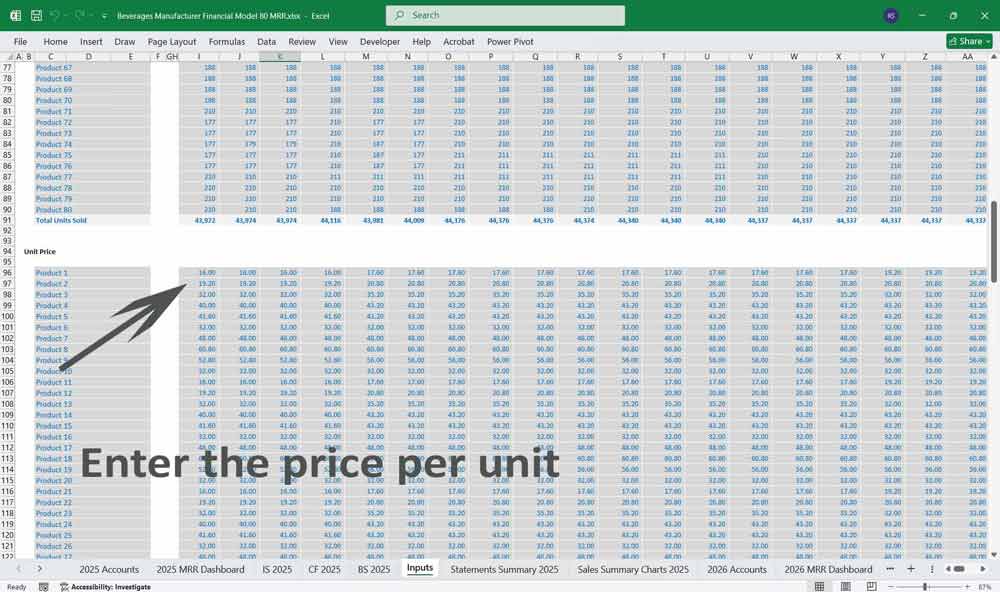
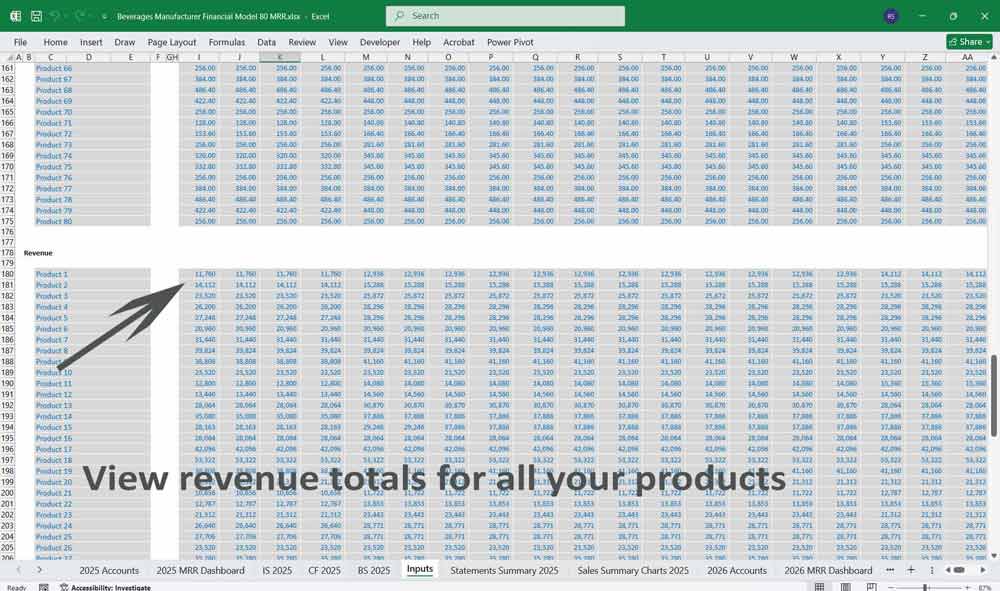
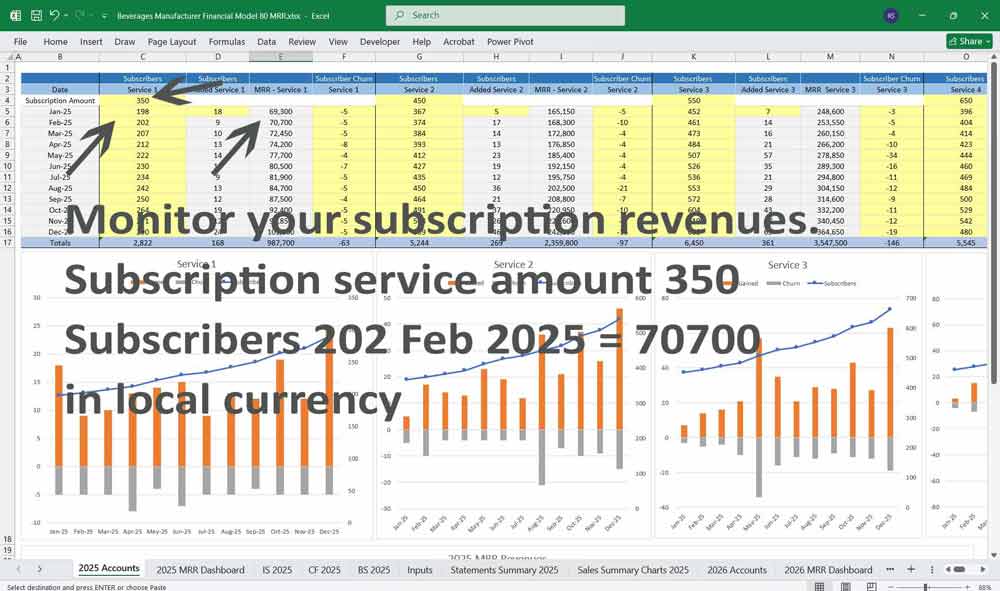
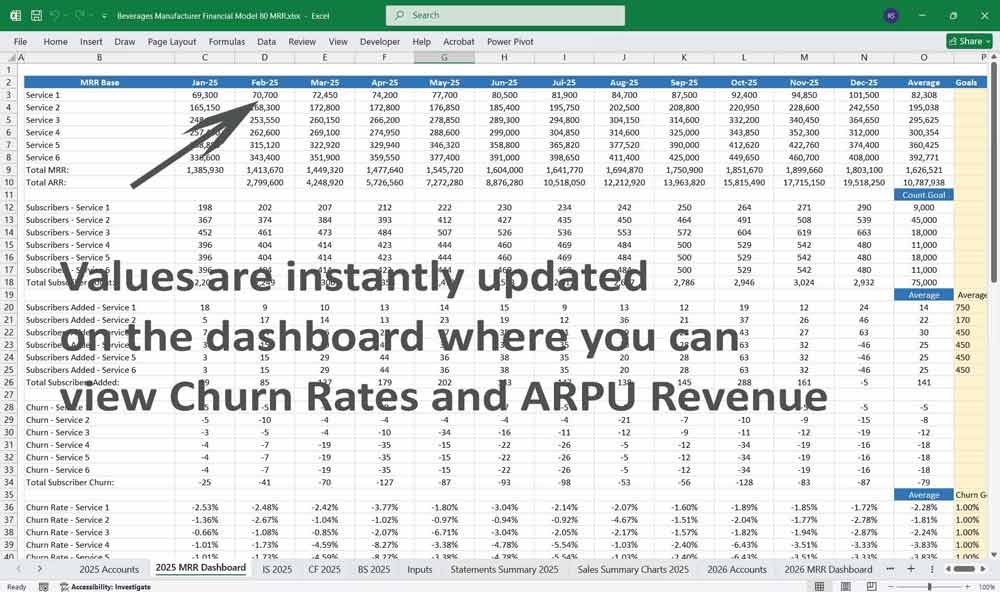
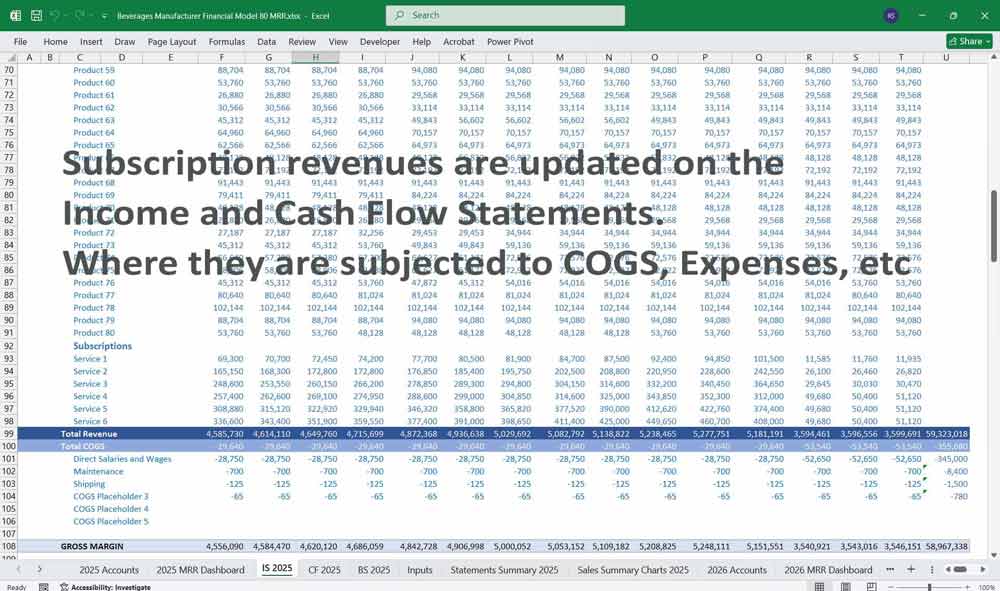
Beverages Manufacturer Financial Model Cash Flow Statement
The Cash Flow Statement tracks actual cash movement, distinguishing between operational, investing, and financing activities.
Operating Cash Flow
Cash Inflows:
- Sales revenue
- Subscription payments
- Receivables collected
Cash Outflows:
- Payments for raw materials
- Salaries and wages
- Rent and utilities
- Advertising spend
Investing Cash Flow
Cash Inflows:
- Sale of old machinery
- Interest earned on investments
Cash Outflows:
- Purchase of equipment and bottling lines
- Expansion into new facilities
Financing Cash Flow
Cash Inflows:
- New equity investment
- Loan proceeds
Cash Outflows:
- Loan repayments
- Dividend distributions
Net Cash Flow = Operating + Investing + Financing Cash Flow
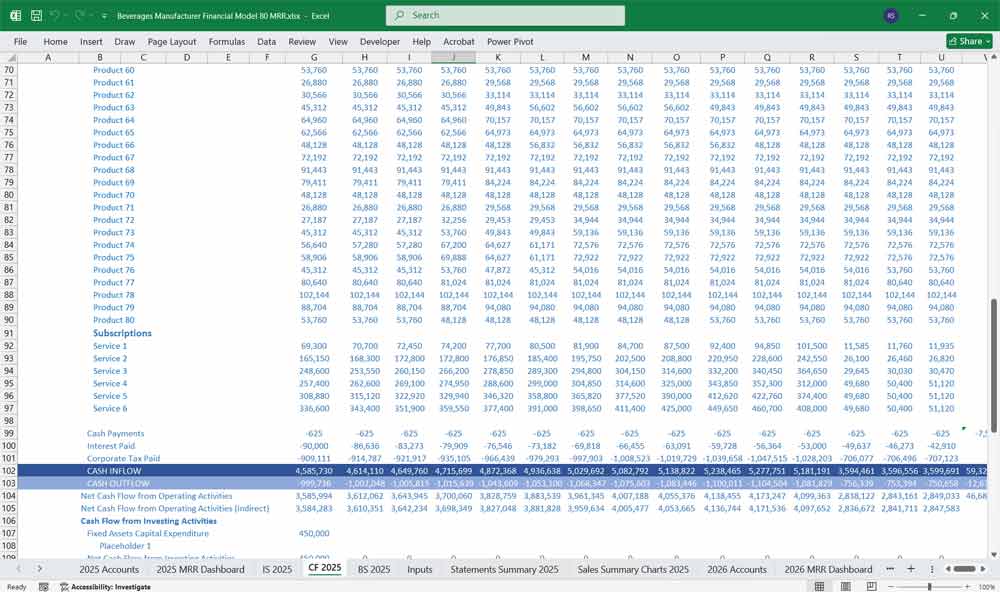
Beverages Manufacturer Financial Model Balance Sheet
The Balance Sheet provides a snapshot of assets, liabilities, and equity.
Assets
Current Assets
- Cash and cash equivalents
- Accounts receivable
- Inventory (raw materials, finished goods)
- Prepaid expenses
Non-Current Assets
- Property, plant, and equipment (factories, bottling lines)
- Intellectual property (formulations, trademarks)
- Goodwill (brand value)
Liabilities
Current Liabilities
- Accounts payable
- Short-term debt
- Accrued expenses
Non-Current Liabilities
- Long-term loans
- Deferred tax liabilities
Equity
- Shareholder’s Equity
- Retained earnings
- Common stock
Total Assets = Total Liabilities + Equity
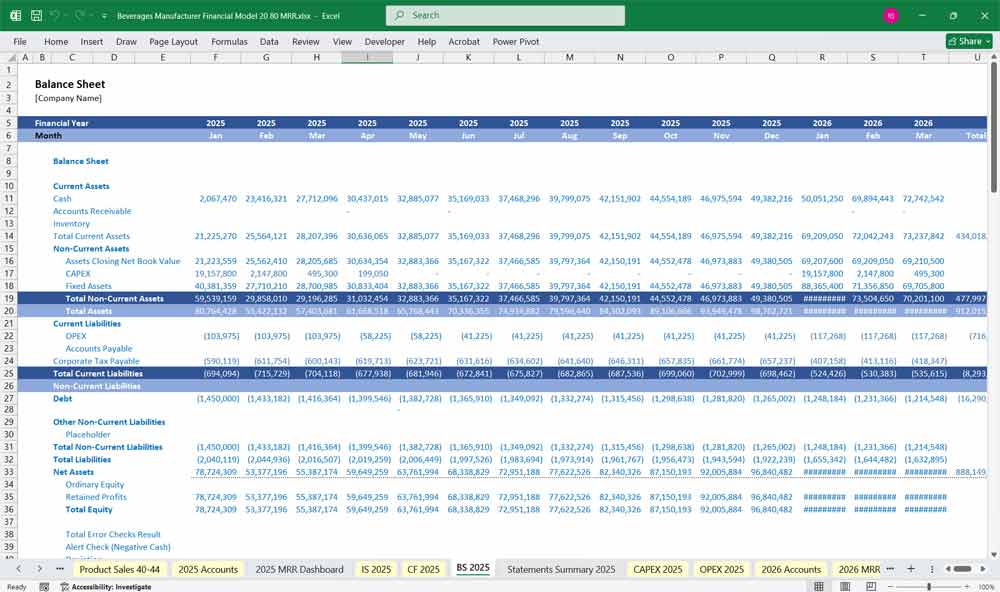

Key Financial Metrics for a Beverage Manufacturer
- Gross Profit Margin = (Gross Profit / Revenue) × 100
- Operating Profit Margin (EBIT Margin) = (EBIT / Revenue) × 100
- Net Profit Margin = (Net Income / Revenue) × 100
- Return on Assets (ROA) = (Net Income / Total Assets) × 100
- Return on Equity (ROE) = (Net Income / Shareholder Equity) × 100
- Debt-to-Equity Ratio = (Total Debt / Shareholder Equity)
- Inventory Turnover = (COGS / Average Inventory)
- Days Sales Outstanding (DSO) = (Accounts Receivable / Revenue) × 365
When structuring product lines for a beverage manufacturer, it’s important to organize them in a way that aligns with customer needs, market demand, and operational efficiency. Below are detailed sections for 40 product lines and 80 product lines, including categorization, examples, and strategic considerations.
Product Line Categorization for a Beverage Manufacturer
A Beverage Manufacturer typically produces a wide range of products for different industries, including wholesale, retail, consumer goods, and specialty events.
40 Product Line Breakdown
1. Carbonated Soft Beverage Drinks (6 Products)
Classic Cola
Diet Cola
Lemon-Lime Soda
Orange Soda
Ginger Ale
Root Beer
2. Sparkling Water (4 Beverage Products)
Plain Sparkling Water
Lemon Sparkling Water
Lime Sparkling Water
Berry Sparkling Water
3. Energy Drinks (4 Beverage Products)
Original Energy Drink
Sugar-Free Energy Drink
Tropical Energy Drink
Citrus Energy Drink
4. Juices (6 Beverage Products)
Apple Juice
Orange Juice
Cranberry Juice
Grapefruit Juice
Pineapple Juice
Mixed Berry Juice
5. Iced Teas (4 Beverage Products)
Classic Black Iced Tea
Green Iced Tea
Peach Iced Tea
Lemon Iced Tea
6. Functional Beverages (4 Products)
Electrolyte Sports Drink
Probiotic Wellness Drink
Vitamin-Infused Water
Detox Herbal Drink
7. Alcoholic Beverages (6 Products)
Hard Seltzer (Lime)
Hard Seltzer (Berry)
Craft Beer (IPA)
Craft Beer (Lager)
Ready-to-Drink Cocktail (Mojito)
Ready-to-Drink Cocktail (Margarita)
8. Non-Alcoholic Beverage (6 Products)
Non-Alcoholic Craft Beer
Non-Alcoholic Wine (Red)
Non-Alcoholic Wine (White)
Non-Alcoholic Gin Alternative
Non-Alcoholic Whiskey Alternative
Non-Alcoholic Sparkling Wine
80 Product Line Breakdown
1. Carbonated Soft Drinks (10 Beverage Products)
Classic Cola
Diet Cola
Lemon-Lime Soda
Orange Soda
Ginger Ale
Root Beer
Cream Soda
Grape Soda
Cherry Cola
Vanilla Cola
2. Sparkling Water (8 Beverage Products)
Plain Sparkling Water
Lemon Sparkling Water
Lime Sparkling Water
Berry Sparkling Water
Cucumber Mint Sparkling Water
Peach Sparkling Water
Raspberry Sparkling Water
Coconut Sparkling Water
3. Energy Drinks (8 Beverage Products)
Original Energy Drink
Sugar-Free Energy Drink
Tropical Energy Drink
Citrus Energy Drink
Berry Blast Energy Drink
Mango Energy Drink
Coffee-Infused Energy Drink
Herbal Energy Drink
4. Juices (10 Beverage Products)
Apple Juice
Orange Juice
Cranberry Juice
Grapefruit Juice
Pineapple Juice
Mixed Berry Juice
Mango Juice
Passionfruit Juice
Pomegranate Juice
Carrot-Orange Blend
5. Iced Teas (8 Beverage Products)
Classic Black Iced Tea
Green Iced Tea
Peach Iced Tea
Lemon Iced Tea
Raspberry Iced Tea
Mango Iced Tea
Hibiscus Iced Tea
Sweet Tea
6. Functional Beverages (8 Products)
Electrolyte Sports Drink
Probiotic Wellness Drink
Vitamin-Infused Water
Detox Herbal Drink
Collagen-Infused Beverage
Adaptogenic Drink (Stress Relief)
Protein-Enhanced Shake
Antioxidant-Rich Superfruit Drink
7. Alcoholic Beverages (10 Products)
Hard Seltzer (Lime)
Hard Seltzer (Berry)
Hard Seltzer (Mango)
Hard Seltzer (Pineapple)
Craft Beer (IPA)
Craft Beer (Lager)
Craft Beer (Stout)
Ready-to-Drink Cocktail (Mojito)
Ready-to-Drink Cocktail (Margarita)
Ready-to-Drink Cocktail (Cosmopolitan)
8. Non-Alcoholic Beverage (10 Products)
Non-Alcoholic Craft Beer
Non-Alcoholic Wine (Red)
Non-Alcoholic Wine (White)
Non-Alcoholic Rosé
Non-Alcoholic Gin Alternative
Non-Alcoholic Whiskey Alternative
Non-Alcoholic Sparkling Wine
Non-Alcoholic Rum Alternative
Non-Alcoholic Tequila Alternative
Non-Alcoholic Aperitif
9. Specialty Beverages (8 Products)
Cold Brew Coffee
Nitro Cold Brew Coffee
Matcha Green Tea Latte
Chai Latte
Golden Turmeric Latte
Kombucha (Original)
Kombucha (Ginger)
Kombucha (Berry)
Conclusion
This 40 & 80 product line breakdown provides a detailed view of the beverage manufacturing industry, categorizing products by construction, automotive, consumer, industrial, and decorative applications.
6-tier subscription model for a Beverage manufacturer
This involves structuring offerings that cater to different customer segments, from small businesses to large enterprises. Each tier should provide increasing value, services, and benefits to justify the higher price points.
Tier 1: Basic Beverage Box
Target Audience: Casual drinkers, first-time customers, or budget-conscious consumers.
Description:
Monthly delivery of a curated selection of the brand’s most popular beverages.
Includes 6-8 standard-sized bottles/cans per month.
Access to basic recipes and pairing suggestions for the beverages.
Limited edition flavors or seasonal offerings may be included occasionally.
Free standard shipping.
Price: 15−15−25/month.
Perks:Discounts on first-time purchases.
Access to a digital newsletter with beverage tips and updates
Tier 2: Premium Beverage Club
Target Audience: Beverage enthusiasts who want a more refined experience.
Description:
Monthly delivery of 10-12 premium or craft beverages, including limited-edition flavors.
Exclusive access to small-batch or experimental flavors not available in stores.
Includes a mix of alcoholic and non-alcoholic options (if applicable).
Personalized tasting notes and pairing guides.
Price: 30−30−50/month.
Perks:Free shipping and early access to new product launches.
Invitations to virtual tasting events.
Tier 3: Connoisseur’s Beverage Collection
Target Audience: Discerning customers who value exclusivity and high-quality beverages.
Description:
Bi-monthly delivery of 12-15 premium, rare, or hard-to-find beverages.
Includes a mix of international flavors, aged beverages, or artisanal creations.
Comes with a detailed booklet about the history, ingredients, and brewing process of each beverage.
Access to a dedicated customer service line for personalized recommendations.
Price: 75−75−100/bi-monthly.
Perks:Complimentary branded glassware or merchandise with every delivery.
Exclusive invitations to in-person tasting events or brewery tours.
Tier 4: Corporate Beverage Gifting Membership
Target Audience: Businesses looking for branded beverage solutions for clients or employees.
Description:
Customizable quarterly deliveries of branded beverages for corporate gifting.
Options for personalized labels, packaging, and messaging.
Includes a mix of alcoholic and non-alcoholic beverages tailored to the recipient’s preferences.
Dedicated account manager for seamless coordination.
Price: 500−500−1,000/quarter (depending on volume and customization).
Perks:Discounts on bulk orders.
Complimentary branded gift boxes or accessories.
Tier 5: VIP Beverage Elite
Target Audience: High-net-worth individuals or superfans of the brand.
Description:
Monthly delivery of ultra-premium, rare, or collector’s edition beverages.
Includes exclusive access to one-of-a-kind flavors, collaborations with renowned mixologists, or vintage collections.
Personalized service with a dedicated concierge to handle requests and preferences.
Complimentary add-ons like gourmet snacks or mixers.
Price: 150−150−300/month.
Perks:VIP access to brand events, including private tastings and launch parties.
Complimentary luxury packaging and expedited shipping.
Opportunity to name or co-create a limited-edition flavor.
Tier 6: Founder’s Circle (Ultimate Beverage Tier)
Target Audience: Brand ambassadors, investors, or ultra-loyal customers.
Description:
Annual membership with unparalleled access to the brand’s most exclusive offerings.
Quarterly delivery of rare, vintage, or custom-crafted beverages, including personalized blends.
Includes a private consultation with the brand’s master brewer or mixologist to create a bespoke beverage.
Access to behind-the-scenes content, including the brand’s R&D process and future plans.
Price: 2,000−2,000−5,000/year.
Perks:Lifetime discounts on all products.
Invitation to an annual Founder’s Circle retreat or exclusive event.
Recognition on the brand’s website or marketing materials as a key supporter.
Additional Considerations Across Tiers
Scalability:
Each tier is designed to be scalable, allowing customers to upgrade as their production needs grow.Integration & API Access:
Higher tiers offer greater levels of system integration, enabling seamless connectivity with in-house systems and real-time tracking.Flexibility:
Options for rollover of unused print credits and flexible overage billing ensure that customers only pay for what they need.Value-Added Services:
Complimentary design consultations, technical support, and training workshops become more prominent in the higher tiers, adding strategic value beyond just production capacity.Service Level Agreements (SLAs):
Defined SLAs across tiers provide transparency regarding turnaround times, quality standards, and uptime guarantees, with the most rigorous SLAs reserved for Enterprise and Premium tiers.
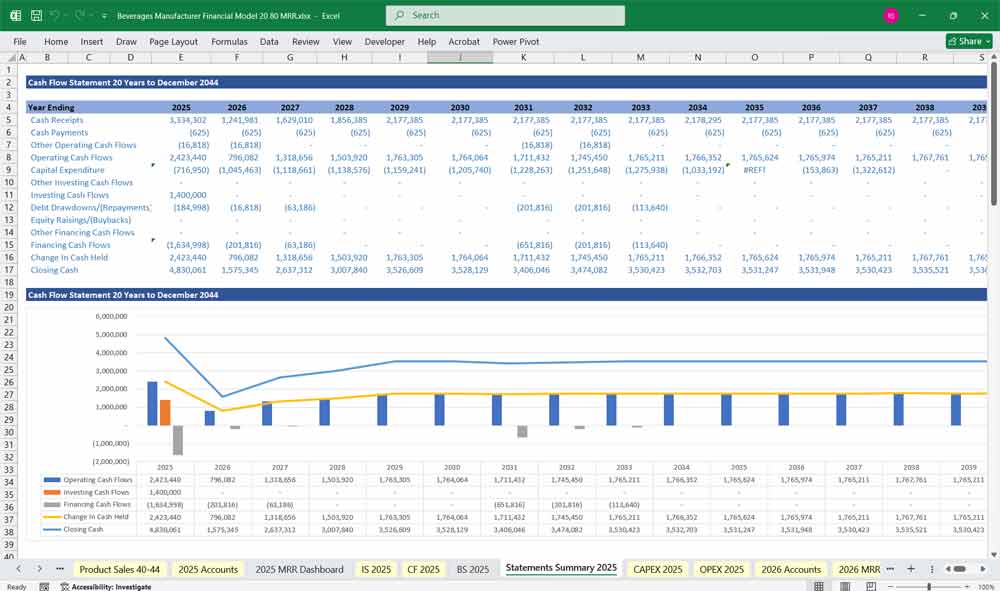
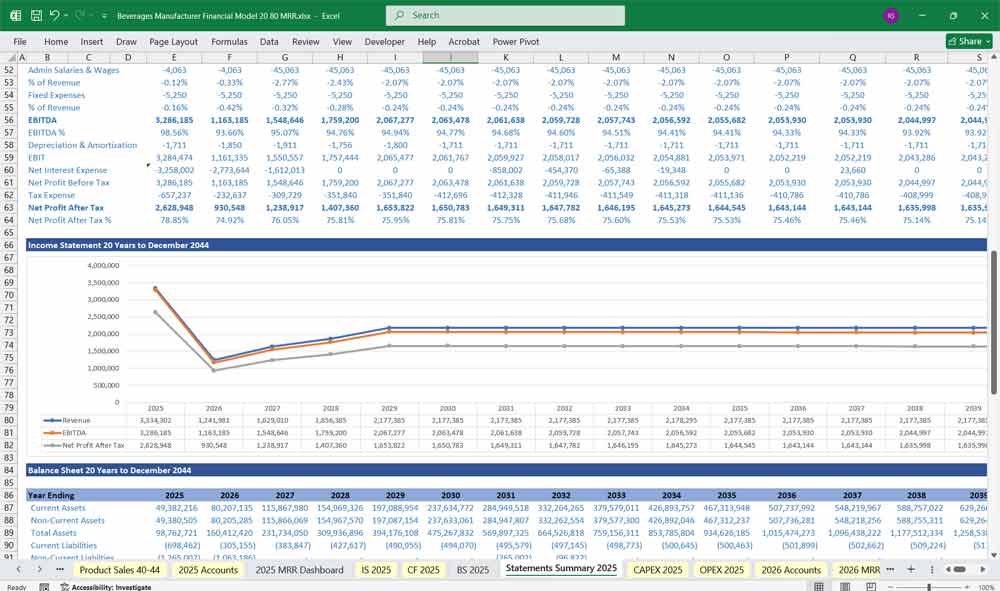
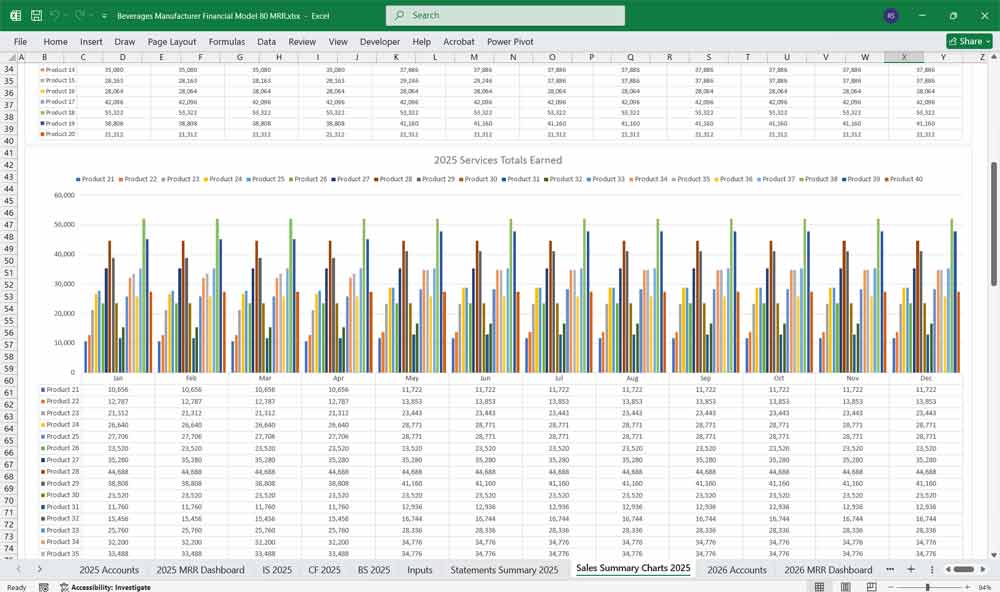
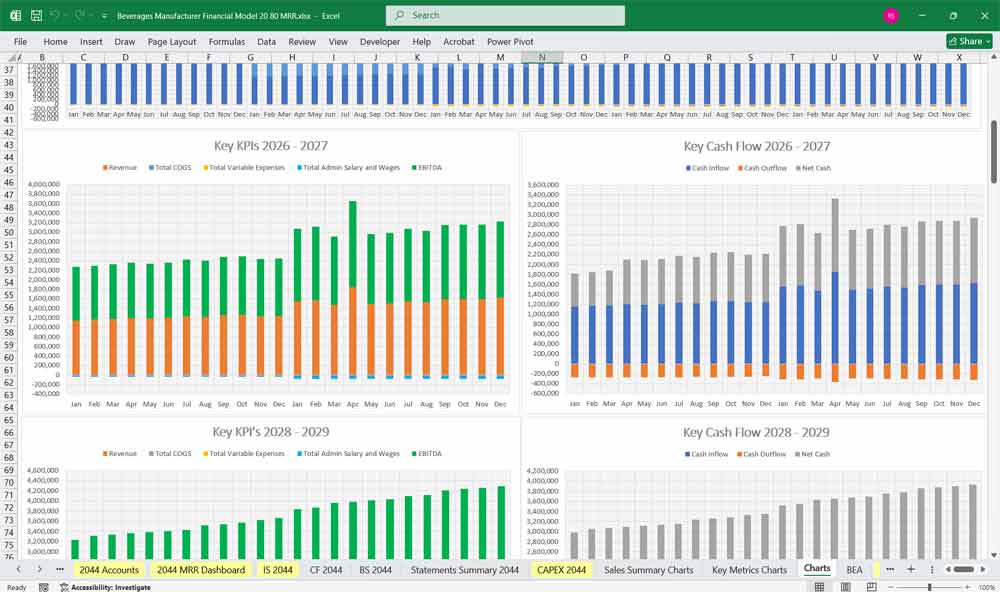
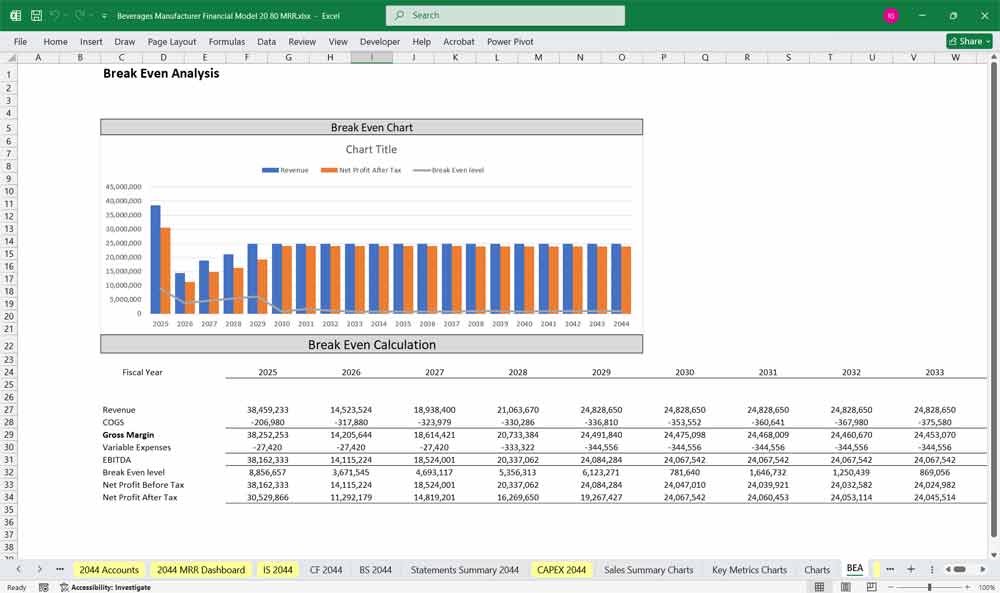
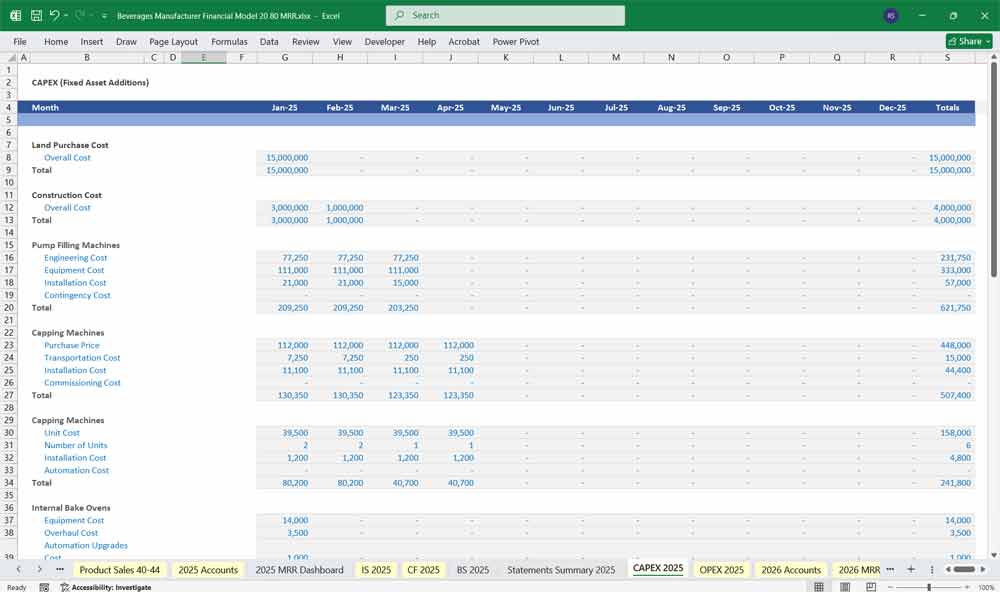
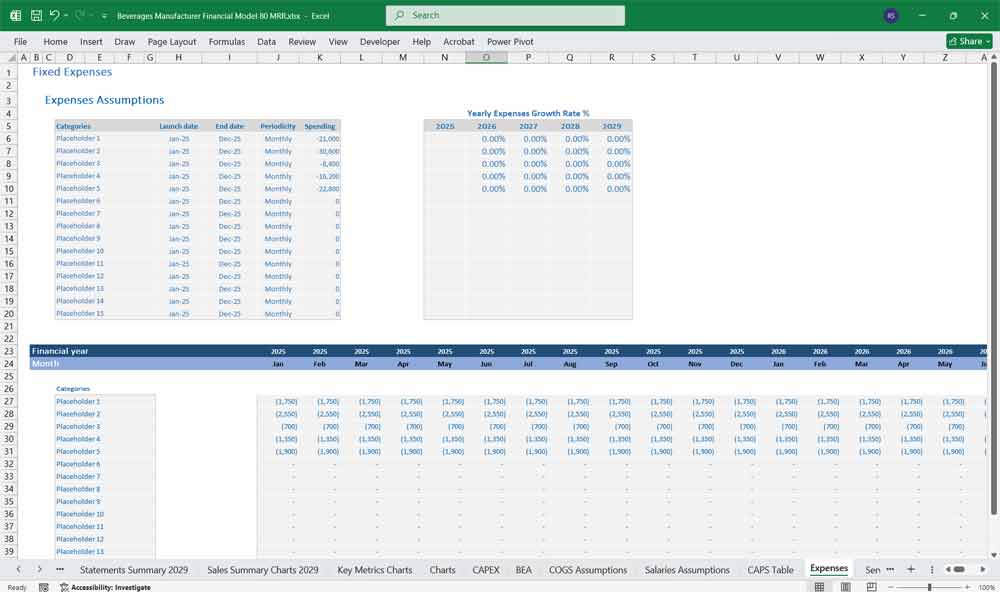
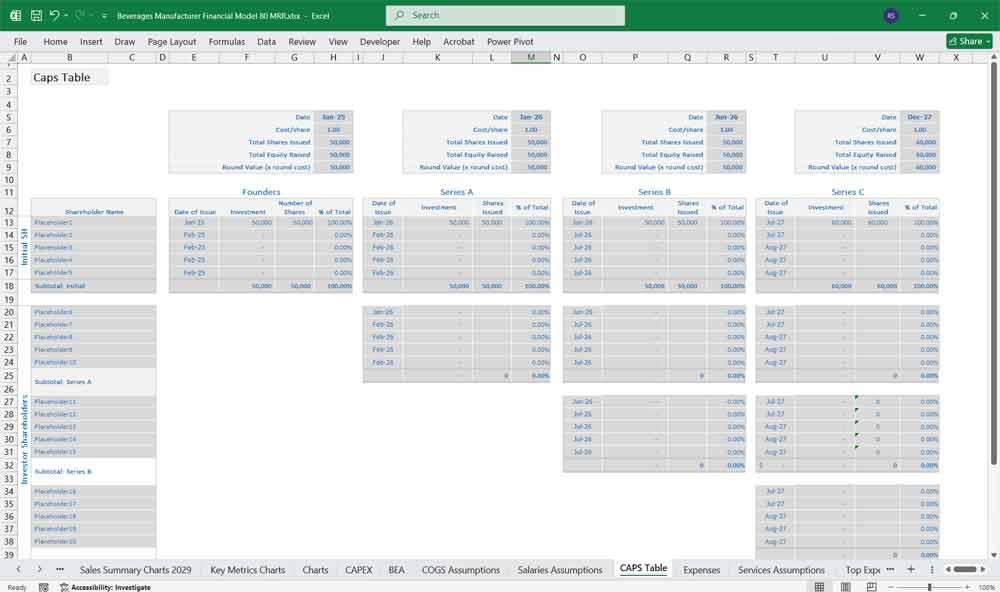
Key Financial Ratios & Metrics
- Gross Profit Margin = (Revenue – COGS) / Revenue
- Operating Margin = Operating Profit / Revenue
- EBITDA Margin = (Earnings Before Interest, Taxes, Depreciation, and Amortization) / Revenue
- Current Ratio = Current Assets / Current Liabilities
- Debt-to-Equity Ratio = Total Debt / Shareholder’s Equity
- Return on Investment (ROI) = Net Profit / Investment Cost
Scenario Analysis
- Best Case: High subscription retention, strong retail demand, cost efficiency.
- Base Case: Steady sales growth with manageable costs.
- Worst Case: Supply chain disruptions, high churn, increased competition.
Conclusion
These Excel financial models for a beverage manufacturer must balance product variety, cost structure, and revenue channels. By incorporating retail sales, bulk distribution, and a 6-tier subscription model, the business can stabilize cash flow and achieve long-term growth
Download Link On Next Page
Download Link On Next Page
